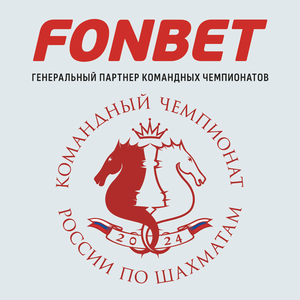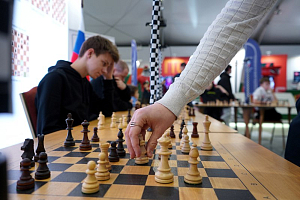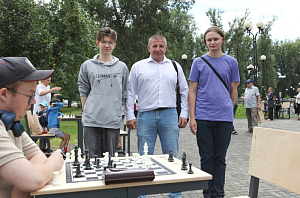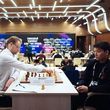18 July 2016
Big Journey of a White Knight
Game two of the Gelfand-Inarkiev match in the review of Vladimir Barsky.
It is not so long ago since Ernesto Inarkiev has included the Nimzo-Indian Defence into his "black" repertoire and has achieved good results in this strategically complex opening. However, the amount of his experience with this opening is clearly not as substantial as that of Boris Gelfand. The Vice-World Champion opted for a rare line, which he used to employ a quite awhile ago, whereas his opponent has no games at all playing this line in the official competitions. Besides, Gelfand went for this line other than empty-handed - at move eleven he challenged his opponent with a pawn sacrifice that had never been seen in the tournament practice. Ernesto wisely refrained from accepting the Greek gift and, having come up with some precise moves, almost equalized the position.
However, White was still retaining some minor pressure as his knight wriggled his way to d6 and was doing a good job giving a lot of headache to his opponent. Meanwhile, time trouble stepped into the matter. At first, Black committed an oversight, upon which he could have ended up being down a pawn. However, the joint post-game grandmaster analysis revealed it to be a very convenient oversight: if White were to go for it, the position would have simplified quickly and Black would have bailed out with a draw in the opposite-colored bishops endgame without any particular problems. Inarkiev was unwilling to part with a pawn, but missed a spectacular combination with a rook sacrifice, which allowed the white queen and knight crack down upon the defenseless black king with all their might. The round-the-world trip of the white knight is worthy paying attention to: g1-f3-d4-b5-d6-f5-h6!
Gelfand – Inarkiev
Nimzo-Indian Defence
1.d4 Nf6 2.c4 e6 3.Nc3 Bb4 4.Nf3 0-0 5.Bg5 h6 6.Bh4 c5 7.Rc1 cd 8.N:d4 d5 9.cd g5 10.Bg3 Q:d5 11.e3
Boris Gelfand: This position is crucial from the theoretical point of view. 11.е3 is a new move. Previously they played 11.а3, but Black stands better after that.
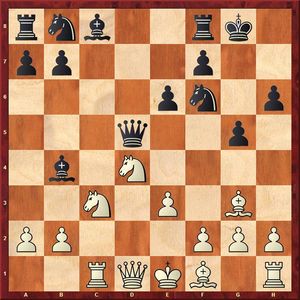
11...Ne4
Boris Gelfand: This is a reasonable continuation, even though Black has a great deal of other moves as well.
Vladimir Barsky The audience was interested in 11...Q:a2.
Boris Gelfand: Let it remain up to your home analysis to find out! It goes without saying that pawn taking is a principled approach.
12.Bd3 B:c3+
Boris Gelfand: Among other continuations, 12...e5 was an option here as well. For example: 13.Ndb5 N:c3 14.bc Q:g2, resulting in a very complex type of position. If now 15.Qh5, then 15…Q:h1+ 16.Kd2 Qc6 (stronger is 16...Qd5! 17.Q:h6 Bf5 18.Q:g5+ Bg6 – editor's note) 17.cb Qf6.
Another option would be 13.0-0 B:c3 14.Nb5 Ba5 15.B:e4 Q:e4 16.Nd6 or 15...Q:b5 16.Qh5 Qb6 (16...Kg7 17.a4! Qe8 18.R:c8!) 17.Rc6, but I thought it was too good to be true to get away with it in a practical game of chess! I am not sure if I could pull off this trick or not. (According to the engine, stronger is 17.h4! Qf6 18.Rc5 with an edge for White – editor's note).
Ernesto Inarkiev: I thought that I was not entitled to force the game with 12...е5 without having my pieces developed first.
13.bc Nd7 14.B:e4
Boris Gelfand: This should be a correct idea. Black intends to deploy his knight on c5 via d7 with a normal position after that.
14...Q:e4 15.0-0 b6 16.Nb5
Boris Gelfand: I felt that the straightforward play with 16.f4 would be too adventurous an undertaking. One minor error would be enough for White to find himself in a lost position.
16...Nc5
Boris Gelfand: This is a strong move that is likely to equalize the game. If 16...Bb7, then 17.f3 Qc6 18.c4, and Black ends up with a very poor bishop on b7. White is going to mound his knight on d6 and double up along the d-file. The edge would be on his side.
17.Nd6 Qg6 18.Qf3 Ba6
Ernesto Inarkiev: Here I had a choice as I could also go for 18...Bd7.
Boris Gelfand: It is hard to say where the bishop is placed better. I believe both moves assure decent play to Black.
19.c4
Boris Gelfand: This is a must since 19.Rfd1 allows 19...Bd3 and the bishop suddenly shows up on e4.
19...Rad8 20.Rcd1
Boris Gelfand: 20.Rfd1 was perhaps a stronger move – it is hard to say. This is way too subtle a detail to lend itself readily to an unambiguous evaluation.
20...Rd7
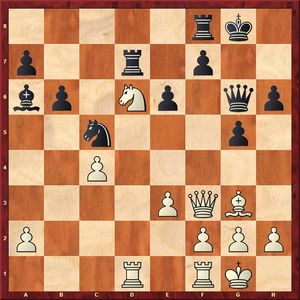
21.Rd4
Ernesto Inarkiev: You gained some time thanks to 21.Rcd1 because I needed to calculate lines after 21.Ne4. This move leads to a draw: 21...R:d1 22.Nf6+ Kg7 23.Nh5+ Kh7.
Boris Gelfand: Even though I also have 21.e4 at my disposal, I am not in time with this move: 21...Rfd8 22.e5 Nb7!, and the с4-pawn is hanging since 23.Qa3? would be bad in view of 23...B:c4. Therefore, 21.Rd4 is a reasonable move, but from now on the subsequent game was dictated by time trouble that started looming on the horizon.
21...f6 22.Rfd1
Boris Gelfand: I probably should have started with 22.h4.
22...Rfd8 23.h4 e5
Boris Gelfand: It was essential that some accurate move be played now, but which one exactly? If 23...Qg7, then 24.Qh5. If 23...Kh7, then 24.Ne4 R:d4 25.R:d4 R:d4 26.N:f6+ Kg7 27.ed Q:f6 28.Be5.
(The engine now suggests moving the rook back 23...Rf8 and evaluates the position as a double-edged one – editor's note.)
24.h5 Qh7?
Boris Gelfand: It was instrumental that Black played 24...Qg7 25.Nf5 Bb7. I wind up winning a pawn, but is it really enough to bring the game home? After 26.Qg4 Qh7 27.N:h6+ Kh8 28.R:d7 R:d7 29.R:d7 Q:d7 30.Q:d7 N:d7 31.f4 the game is about to end in a draw: 31...ef 32.ef Ba6.
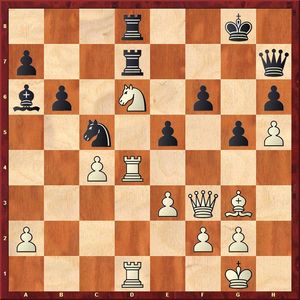
25.Q:f6!
Boris Gelfand: Strange as it may seem, White is already winning, in my opinion.
25...ed (25...Rf8 26.Q:e5) 26.Nf5 de
Boris Gelfand: There is a nice line here: 26...Ne4 27.N:h6+ Q:h6 28.Q:h6 Rd6 – and the queen is trapped. However, White emerges with way too much material out of this line: 29.B:d6 R:d6 30.Q:d6 N:d6 31.R:d4. A rook and three pawns for a bishop and a knight, coupled with poor coordination of the black pieces.
27.R:d7 R:d7
27...ef+ 28.B:f2 Q:d7 29.N:h6+ Kh7 30.Qg6+ Kh8 31.Nf7+ does not offer much of a relief.
28.N:h6+ Q:h6 29.Q:h6 ef+
If 29...e2, then 30.Qg6+ Rg7 (30...Kf8 31.Bd6+ R:d6 32.Q:d6+ Kf7 33.Qg6+) 31.Qe8+, and the е2-pawn goes down.
30.B:f2 B:c4 31.B:c5 bc 32.Q:g5+
As was pointed out by Ernesto Inarkiev, 32.Qg6+ was a quicker way to the goal, for example: 32...Kf8 (32...Rg7 33.Qe8+ Kh7 34.Qe4+) 33.Qf5+ Rf7 (33...Ke8 34.Qe4+) 34.Q:c5+.
32...Rg7 33.Q:c5 Bf7 34.Qf5 Be8 35.g4 Bd7 36.Qd5+ Black resigns.
On the same day the Cultural Centre of Magas gave start to the Junior Russian Cup "The Promising Players of the North Caucasus." It is quite symbolic that all groups gathered a total of 64 participants - a number that is associated with chess!








